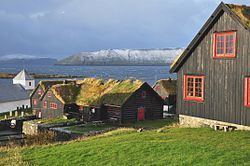State Kingdom of Denmark Postal code FO 175 Local time Tuesday 6:17 PM | Time zone GMT Climate Cfc Population 75 (1 Jan 2009) | |
 | ||
Weather 6°C, Wind N at 72 km/h, 63% Humidity | ||
Faroe islands t rshavn kirkjub ur fer er
Kirkjubøur (Danish: Kirkebø) is the southernmost village on Streymoy, Faroe Islands and the country's most important historical site with the ruins of the Magnus Cathedral from around 1300, the Saint Olav's Church from 12th century and the old farmhouse Kirkjubøargarður from 11th century. In 1832 a runestone was found near the Magnus Cathedral in Kirkjubøur. The stone which is referred to as the Kirkjubøur stone dates back to the Viking Ages.
Contents
- Faroe islands t rshavn kirkjub ur fer er
- Map of KirkjubC3B8ur Faroe Islands
- History
- People
- Kirkjubur pew ends
- References
Map of Kirkjub%C3%B8ur, Faroe Islands
The village is located on the south-west coast of Streymoy and has a view towards the islands Hestur and Koltur towards west and to Sandoy towards south.
The little islet just of the coast, Kirkjubøhólmur contains an eiderduck colony.
To the village belongs the islet Trøllhøvdi, just 100 m of the northern tip of Sandoy 9 km away from Kirkjubø, it was given as payment to the villagers as it was their duty to ferry people across to Sandoy in medieval times.
History
The village was important in the Middle Ages. At that time it was the episcopal residence for the Diocese of the Faroe Islands and as such the spiritual centre of the society. In those days the village is said to have had around 50 houses. The majority of these houses were washed away by a fierce storm in the 16th century, which created the islet Kirkjubøhólmurin, which contains ruins from that time.
It is speculated that the church located the diocese in Kirkjubø, to counter the heathen Vé in Velbastaður only 5 km to the north west up the coast.
There are three main attractions from this time:
People
Many prominent people come from Kirkjubøur or have been living here:
Kirkjubøur pew ends
The mediaeval carved pew ends from Saint Olav's church are now to be found in the National Museum of the Faroe Islands. These featured in three series of Faroese stamps, engraved by Czeslaw Slania. For the full series, see here.
